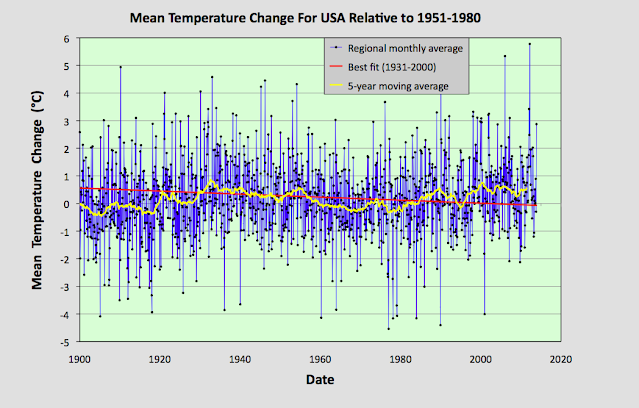Over the next few weeks I will examine some of the temperature records from Asia. This post will consider those from South-East Asia, and the countries of Burma (Myanmar), Thailand, Malaysia, The Philippines and Vietnam. Laos and Cambodia have been excluded because they have very little temperature data. Data for Singapore is incorporated into the analysis of data for Malaysia.
Fig. 69.1: The number of station records included each month in the mean temperature trend for five countries in South-East Asia.
In each case the temperature trend for the country was constructed by averaging the temperature anomalies from multiple station time-series. Different time periods were chosen for calculating the monthly reference temperatures (MRTs) for each country due to differences in the distribution of data in each case. These are indicated on the graphs below. For an explanation of how anomalies and MRTs are calculated, see Post 47.
The number of available series for each country are shown in Fig. 69.1 above. In all five cases there is much more data after 1950 and very little before 1900, and Thailand and The Philippines clearly have more data than the other three countries. However, Burma does have three long stations with over 1200 months of data, whereas Thailand only has one. Vietnam and Malaysia also have three long stations, although in the case of Malaysia that includes a station in Singapore, while The Philippines has two long stations. The analysis here used data only from long stations (with over 1200 months of data) and medium stations with over 480 months. In total Burma has 13 medium stations, Thailand has 55, Malaysia has 17, The Philippines has 35, and Vietnam has 10.
Fig. 69.2: The temperature trend for Burma. The best fit is applied to the monthly mean data from 1875 to 1992 and has a negative gradient of -0.13 ± 0.05 °C per century. The monthly temperature changes are defined relative to the 1961-1990 monthly averages.
Fig. 69.3: The temperature trend for Thailand. The best fit is applied to the monthly mean data from 1934 to 2008 and has a positive gradient of +0.14 ± 0.09 °C per century. The monthly temperature changes are defined relative to the 1961-1990 monthly averages.
Fig. 69.4: The temperature trend for Malaysia. The best fit is applied to the monthly mean data from 1881 to 2000 and has a negative gradient of -0.06 ± 0.03 °C per century. The monthly temperature changes are defined relative to the 1951-1980 monthly averages.
Fig. 69.5: The temperature trend for The Philippines. The best fit is applied to the monthly mean data from 1914 to 2007 and has a positive gradient of +0.24 ± 0.04 °C per century. The monthly temperature changes are defined relative to the 1951-1980 monthly averages.
Fig. 69.6: The temperature trend for Vietnam. The best fit is applied to the monthly mean data from 1901 to 2010 and has a positive gradient of +0.09 ± 0.05 °C per century. The monthly temperature changes are defined relative to the 1981-2010 monthly averages.
The graphs above indicate that there has been little, if any, climate change in the region in the last 100 years. The only country to show any significant warming has been The Philippines, and here it is less than 0.25°C. Burma may have seen a temperature rise of almost 1 °C since 1970, but beforehand the climate cooled by about 0.5°C. In all other cases the temperature appears to be stable. This is consistent with my previous analysis of temperature data for Indonesia (see Post 31), but it is not what is claimed by Berkeley Earth, though.
Fig. 69.7: The temperature trend for Thailand since 1800 according to Berkeley Earth.
According to Berkeley Earth there has been over 1.5°C of warming in Thailand since 1840 (see Fig. 69.7 above), with 0.5°C coming before 1900 despite there being no significant increase in carbon dioxide levels before 1900 (they were at 296 ppm compared to 283 ppm in 1800), and despite there being virtually no temperature data (Thailand has only one significant station with data before 1930).
The differences between the trend in Fig. 69.7 and that presented in Fig. 69.3 are due to the adjustments made to the data by Berkeley Earth. Averaging the Berkeley Earth adjusted data for the same stations used to derive the trend in Fig. 69.3 yields the curves in Fig. 69.8 below. These are almost identical to the curves shown in Fig. 69.7, thereby indicating that the adjustments are the source of the difference. This difference due to the Berkeley Earth adjustments amounts to an additional warming of 0.85°C since 1900. Without those adjustments there is virtually no warming.
Fig. 69.8: Temperature trends for Thailand since 1900 based on an average of Berkeley Earth adjusted data. The best fit linear trend line (in red) is for the period 1906-2005 and has a gradient of +0.72 ± 0.03 °C/century.
Another feature of note in the trends shown here are the standard deviations of the data. These are much less than those seen for countries in Europe, or states in the USA. In fact they are typically less than half. This suggests that temperatures near the Equator are much more stable than those nearer the poles. This in turn, suggests that as the local temperature increases, there are stronger negative feedbacks available that help to regulate that temperature. One such feedback is likely to be water vapour and associated cloud coverage. If so, then this would imply that water vapour is not the strong amplifier of climate change as is often suggested by climate scientists, at least not within the Tropics.
Conclusion
There has been no global warming or climate change in South-East Asia over the last 100 years.



























